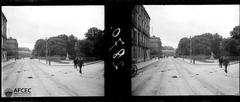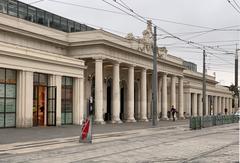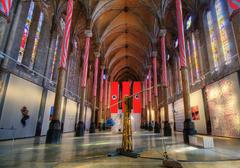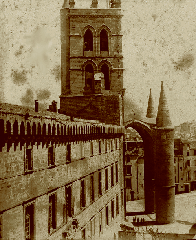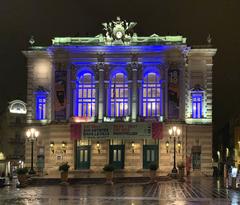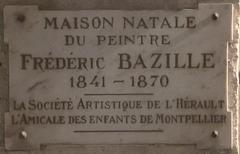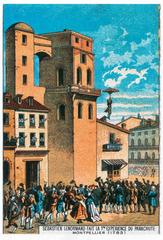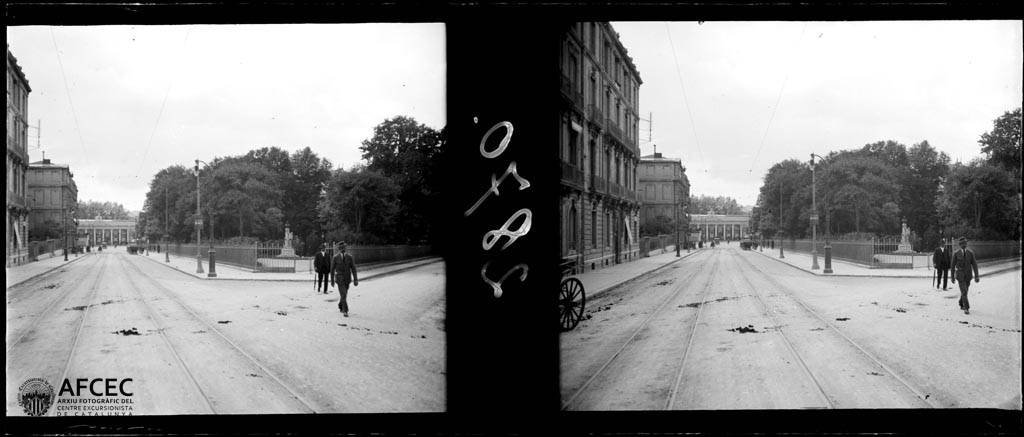
Montpellier-Saint-Roch Railway Station: Visiting Hours, Tickets, and Travel Guide
Date: 14/06/2025
Introduction
Montpellier-Saint-Roch Railway Station stands as both a historic icon and a contemporary transport hub, serving as the primary gateway to Montpellier and the greater Occitanie region of southern France. Originally built in the 19th century, the station has evolved through successive periods of modernization, blending its preserved architectural heritage with cutting-edge design and functionality. Today, Montpellier-Saint-Roch seamlessly connects high-speed TGV and regional rail services with Montpellier’s extensive tram and bus networks, offering travelers efficient, accessible, and enjoyable passage to the heart of the city and beyond (Wikipedia; e-architect).
This comprehensive guide provides essential information for both first-time visitors and seasoned travelers, including a detailed look at the station’s history, facilities, accessibility, ticketing options, and tips for exploring nearby attractions. Whether you’re passing through or starting your Occitanie adventure, this resource will help you make the most of your experience at one of southern France’s most important railway stations.
Table of Contents
- History and Evolution
- Architectural Significance and Station Layout
- Practical Visitor Information
- Getting To and From the Station
- Nearby Attractions and Travel Tips
- FAQs
- Call to Action
- Sources
History and Evolution
Origins and Early Development
Montpellier-Saint-Roch Railway Station, initially known as Gare de Montpellier or Gare PLM, was established in the 19th century to serve the fast-growing city and facilitate connections across the Languedoc region. Its strategic placement at kilometer point 76.959 on the Tarascon–Sète-Ville railway ensured vital links between Montpellier and both regional and national destinations (Wikipedia).
20th-Century Modernization
The transition from the steam era culminated with the last steam locomotive’s departure in 1973. In the 1970s and 1980s, significant modernization works were completed: a new concrete slab above the tracks accommodated a relocated bus station, creating a fully integrated transport hub (Wikipedia). In 1980, a major reconstruction preserved the central historic façade while expanding and updating passenger areas, setting the stage for high-speed TGV services introduced in 1982.
TGV Era and Urban Renewal
The arrival of the TGV in the 1980s dramatically reduced travel times to Paris and enhanced regional mobility. The opening of Montpellier’s first tram line in 2000 further integrated the station into the urban fabric, while the area around the station was transformed to prioritize pedestrian access, public transport, and parking.
Renaming and Cultural Significance
In 2005, the station was renamed Montpellier-Saint-Roch to honor the city’s patron saint and highlight its location in the vibrant Saint-Roch district. This change also reflects the ongoing urban redevelopment projects and the station’s growing cultural role (Wikipedia).
21st-Century Redevelopment
A major redevelopment in the 2010s, led by architect Marc Mimram, introduced the innovative “Garden Station” concept. This project emphasized transparency, natural light, and green public spaces, accommodating increasing passenger flows while integrating the station seamlessly with the surrounding urban environment (e-architect).
Architectural Significance and Station Layout
Montpellier-Saint-Roch’s architecture is a harmonious blend of preserved 19th-century elements and contemporary design. The historic stone façade is juxtaposed with modern glass, steel, and open-plan interiors, creating an inviting atmosphere for travelers.
Station Layout
- Upper Concourse (NEF): Houses ticket offices, shops, dining, and passenger amenities.
- Lower Concourse: Provides direct platform access and essential services.
- Entrances: Main access points from Pont de Lattes and Pont de Sète.
- Platform Access: Step-free via elevators, escalators, and ramps.
Practical Visitor Information
Visiting Hours
- Station Opening: Daily from 5:00 AM to midnight.
- Ticket Offices: Approximately 6:00 AM to 10:00 PM.
- Shops & Dining: Typically 6:00 AM to 10:00 PM, with some variation.
- Automated Ticket Machines: 24/7 access.
Ticketing and Booking
- Self-Service Machines: Multilingual, accepting cards and mobile payments.
- Ticket Offices: Staffed counters for TGV, Intercités, TER, and regional LiO Train services.
- Online/Mobile: Purchase tickets via SNCF platforms or apps.
- Advance Booking: Recommended for best rates and availability, especially for TGV and international routes.
Accessibility
Montpellier-Saint-Roch is fully accessible:
- Elevators, ramps, and tactile guides.
- Accessible restrooms and step-free access throughout.
- Services for visually and hearing-impaired travelers.
- Dedicated assistance available via SNCF Accès Plus (advance booking advised).
Station Facilities
- Shops & Eateries: PAUL Bakery, Starbucks, Quick, Relay newsagents, Monop’Daily, and more.
- Amenities: Left-luggage lockers, toilets, water fountains, children’s play area, public piano, lost & found, defibrillators.
- Wi-Fi: Complimentary in public areas.
Getting To and From the Station
Local Transport Connections
- Tram: All four lines (1, 2, 3, 4) stop at or near the station (TaM Montpellier Public Transport).
- City & Regional Buses: Extensive coverage via TaM and Hérault Transport.
- Bike Sharing: Vélomagg stands at the station for convenient cycling.
Taxi and Bike Options
- Taxi Rank: Located outside main exits, with multilingual drivers and special service options.
- Bike Sharing: Vélomagg stations for eco-friendly travel.
Nearby Attractions and Travel Tips
Montpellier-Saint-Roch’s central location puts you in immediate proximity to top city sights:
- Historic Écusson District: Medieval streets, shops, and cafés.
- Place de la Comédie: Lively main square and focal point for city events.
- Saint-Pierre Cathedral: Majestic Gothic monument, just a 10-minute walk.
- Jardin des Plantes: France’s oldest botanical garden.
- Musée Fabre: Renowned art museum.
- Antigone District: Striking neoclassical architecture.
Travel Tips:
- Purchase a combined tram/bus pass for savings.
- Store luggage in station lockers to explore unencumbered.
- Check local tourism websites for guided tour schedules and seasonal events (Montpellier Tourism Office).
Frequently Asked Questions (FAQ)
Q: What are the visiting hours for Montpellier-Saint-Roch Railway Station?
A: Daily from 5:00 AM to midnight. Ticket offices generally operate from 6:00 AM to 10:00 PM.
Q: Where can I buy tickets?
A: At self-service machines, staffed ticket offices, or online/mobile via SNCF platforms.
Q: Is the station accessible for travelers with reduced mobility?
A: Yes, with elevators, ramps, tactile guides, and dedicated assistance.
Q: Are there luggage storage facilities?
A: Yes, left-luggage lockers are available near the lost & found office.
Q: What are the best nearby attractions?
A: The Écusson district, Place de la Comédie, Saint-Pierre Cathedral, and Musée Fabre are all within walking distance.
Q: Are guided tours available?
A: Occasionally, guided tours depart near the station; check with the Tourism Office.
Call to Action
Plan your visit to Montpellier-Saint-Roch Railway Station now! For real-time updates and ticket bookings, download the Audiala app. Explore our related guides to discover Montpellier’s historic sites, culinary hotspots, and the best tips for navigating the Occitanie region. Follow us on social media for travel inspiration and local event updates.
Sources
- Gare de Montpellier-Saint-Roch - Wikipedia
- Montpellier New TGV Station - e-architect
- Top Rated Attractions & Things to Do in Montpellier - PlanetWare
- TaM Montpellier Public Transport
- Montpellier Tourism Office
- TER Occitanie Official Website
- Audiala App
